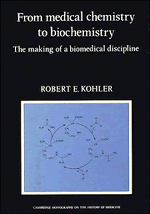Book contents
- Frontmatter
- Contents
- 1 Introduction: On discipline history
- 2 Physiological chemistry in Germany, 1840–1900
- 3 Physiology and British biochemists, 1890–1920
- 4 General biochemistry: the Cambridge school
- 5 European ideals and American realities, 1870–1900
- 6 The reform of medical education in America
- 7 From medical chemistry to biochemistry: the emergence of a discipline
- 8 Unity in diversity: the American Society of Biological Chemists
- 9 The clinical connection: biochemistry as applied science
- 10 Chemical ideals and biochemical practice
- 11 Biological programs
- 12 Epilogue: Toward a molecular biology?
- Location of archival sources and abbreviations
- Notes
- Index
3 - Physiology and British biochemists, 1890–1920
Published online by Cambridge University Press: 07 October 2011
- Frontmatter
- Contents
- 1 Introduction: On discipline history
- 2 Physiological chemistry in Germany, 1840–1900
- 3 Physiology and British biochemists, 1890–1920
- 4 General biochemistry: the Cambridge school
- 5 European ideals and American realities, 1870–1900
- 6 The reform of medical education in America
- 7 From medical chemistry to biochemistry: the emergence of a discipline
- 8 Unity in diversity: the American Society of Biological Chemists
- 9 The clinical connection: biochemistry as applied science
- 10 Chemical ideals and biochemical practice
- 11 Biological programs
- 12 Epilogue: Toward a molecular biology?
- Location of archival sources and abbreviations
- Notes
- Index
Summary
In Britain biochemistry developed within departments of physiology, beginning as a specialized subfield, chemical physiology, and gradually achieving independent status as a separate discipline. This was the prevalent German pattern; alternative German modes were virtually absent. There were regional differences, but what is striking is the consistency of British biochemical institutions (see Table 3.1). Lectureships, or assistant professorships, in chemical physiology were first established in the leading medical schools during the period from 1895–1905; the smaller provincial universities of the midlands followed suit from 1909 to 1914, and the larger technological universities in the 1920s.
There were a few exceptions: at Bristol University and Imperial College, biochemistry was attached to chemistry and botany. Chemist Chaim Weizmann was a lecturer and then a reader in biochemistry (really fermentation chemistry) in William Perkins's department of chemistry at Manchester from 1910 to 1915. The most important exception was Liverpool University, where the first chair of biochemistry was established in the School of Public Health. But within a decade it too had reverted to the norm, a chair of chemical physiology. Roles for biochemists were established in a few London hospitals; R. H. A. Plimmer and John A. Gardner taught biochemistry at St. Thomas's and St. George's before World War I. E. C. Dodds made the Courtauld Institute of Pathology at Middlesex Hospital into a leading center of clinical biochemistry in the 1920s. But these were marginal to the mainstream of the discipline.
- Type
- Chapter
- Information
- From Medical Chemistry to BiochemistryThe Making of a Biomedical Discipline, pp. 40 - 72Publisher: Cambridge University PressPrint publication year: 1982

